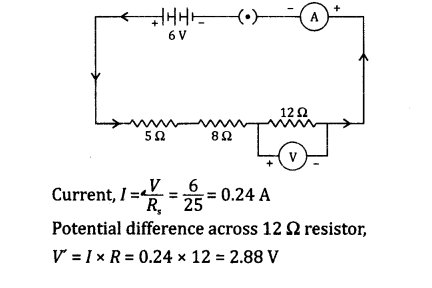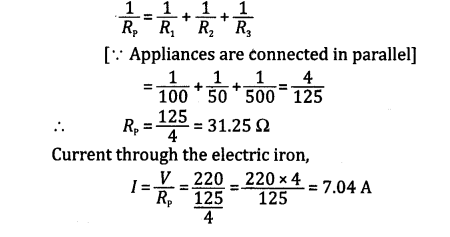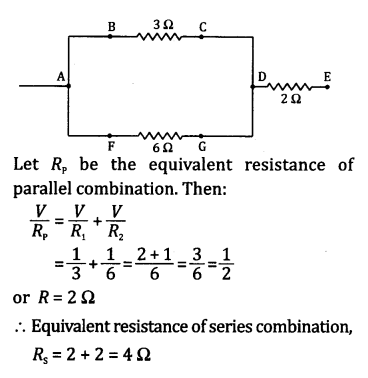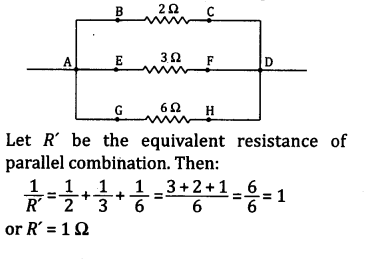Electricity
NCERT Questions
1.What does an electric circuit mean?
ans:A continuous and closed path of an electric current is called an electric circuit
2.Define the unit of current?
ans:One ampere is the current flowing through a circuit, when a charge of one coulomb flows through it in one second
3.Calculate the number of electrons constituting one coulomb of charge?
ans:Total charge, Q = n x e

4.Name a device that helps to maintain a potential difference across a conductor?
ans:With the help of a cell or a battery
5.What is meant by saying that potential difference between two points is 1 volt?
ans:It means that 1 joule work is done in moving 1 coulomb of positive charge from one point to the other in an elecfric field
6.How much energy is given to each coulomb of charge passing through a 6 V battery?
ans:Potential difference (V) = 6 V
Charge (Q) = 1 coulomb
Energy = Q x V x 6 = 6 J
7.On what factors does the resistance of a conductor depend?
ans:Resistance of a conductor depends on its material, length and area of cross-section
8.Let the resistance of an electrical component remains constant while the potential difference across the two ends of the component decreases to half of its former value. What change will occur in the current through it?
ans:According to Ohm law, we have:
I ? V or V ? I
Since the potential difference (V) decreases to half, i.e.
? V2?Ie
Hence, the current flowing through the component will become half
9.Why are coils of electric toasters and electric irons made of an alloy rather than a pure metal?
ans:This is because of the high resistivity and high melting point of the alloy. Also, they do not oxidise when red hot
10.Draw a schematic diagram of a circuit consisting of a battery of three cells of 2 V each, a 5 Ω resistor, an 8 Ω resistor, and a 12 Ω resistor, and a plug key, all connected in series?
ans:

11.Will current flow more easily through a thick wire or a thin wire of the same material when connected to the same source? Why?
ans:The current will flow more easily through a wire which have comparatively less resistance. According to the relation R?1A, the thin wire has less resistance. So, the current will flow more easily through thin wire
12.Judge the equivalent resistance when the following are connected in parallel?
- 1 Ω and 106 Ω
- 1 Ω and 103 Ω, and 106 Ω
ans:
- Approximately but less than 1 Ω, because in a parallel combination of resistors, the equivalent resistance is less than the least resistance
- Same as in previous part of the question
13.Redraw the circuit of previous question putting in an ammeter to measure the current through the resistors and a voltmeter to measure the potential difference across the 12 Ω resistor. What would be the readings in the ammeter and the voltmeter?
ans:Total resistance, Rs = 5 + 8 + 12 = 25 Ω

14.An electric lamp of resistance 100 12, a toaster of resistance 50 11 and a water filter of resistance 500 12 are connected in parallel to a 220 V source. What is the resistance of an electric iron connected to the same source that takes as much current as all three appliances, and what is the current through it?
ans:Given: Resistance of electric lamp, R1 = 100Ω
Resistance of toaster, R2 = 50Ω
Resistance of water filter, R3 = 500Ω
Voltage, V = 220 V
Let Rp be the resistance of electric iron. Then

15.What is (a) the highest, (b) the lowest total resistance that can be secured by combinations of four coils of resistances 4 Ω, 8 Ω, 12 Ω, 24 Ω?
ans:
- The highest resistance can be secured by connecting all the four coils in series.
? Equivalent resistance of series combination, Rs= 4 + 8 + 12+ 24 = 48 Ω
Hence, the highest resistance that can be secured by given coils is 48 Ω
- The lowest resistance can be secured by connecting all the four coils in parallel.
? Equivalent resistance of parallel combination,
1Rp=14+18+112+124=12
or Rp = 2 Ω
Hence, the lowest resistance that can be secured by given coils is 2 Ω
16.Why does the cord of an electric heater not glow while the heating element does?
ans:The resistance of metal used in cord has much lower than that its element. So the heat produced by the element is much more than that produced by the cord while passing the current
17.Compute the heat generated while transferring 96000 coulomb of charge in one hour through a potential difference of 50 V?
ans:Given, Q = 96000 C, V= 50 volt,
t = 1 hour = 60 x 60 = 3600 s
? Heat generated, H = VIt
= VQ = 50 x 96000
= 4800000 = 4.8 x 106 J
18.An electric iron of resistance 20 12 takes a current of 5 A. Calculate the heat developed in 30 s?
ans:Heat developed is equal to the work done (W).
Given: R = 20 Ω, I = 5 A and t = 30 s
? W = I2Rt = (5)2 x 20 x 30
= 25 x 20 x 30 = 15,000 J
Hence, the heat developed by electric iron is 15,000 J
19.What determines the rate at which energy is delivered by a current?
ans:Electric power determines the rate at which energy is delivered by a current
20.An electric motor takes 5 A from a 220 V line. Determine the power of the motor and the energy consumed in 2 hr?
ans:Given: Current, I = 5 A, Voltage, V = 220 V and t= 2 h
Electric power, P=VI = 220 x 5 = 1100 W
? Energy consumed = Pt = 1100 x 7200
= 7920000 = 792 x 104 J
21.What are the advantages of connecting devices in parallel with the battery instead of connecting them in series?
ans:
- When electrical devices are connected in parallel, each is operated at the same voltage and if one of them goes off, the others are not affected. But when electrical devices are connected in series, this does not happen because the circuit is broken when any one of the devices fails
- In parallel connection, the current divides itself through different devices. This is helpful when each device has different resistance and requires different current to operate. But in series connection this does not happen because the same current flows through all the devices
22.How can three resistors of resistances 2 Ω, 3 Ω and 6 Ω be connected to give a total resistance of?
ans:
- In order to get a resistance of 4 Ω, we can connect resistors of 3 Ω and 6 Ω in parallel and this parallel combination in series with 2 Ω resistor

- In order to get 1 Ω resistance, we can connect all the three resistors in parallel

3.twoconductingwiresofthesamematerialandofequallengthsandequaldiametersarefirstconnectedinseriesandthenparallelinacircuitacrossthesamepotentialdifference.theratioofheatproducedinseriesandparallelcombinationwouldbe?
ans:
4.anelectricbulbisrated220vand100w.whenitisoperatedon110v,the)aowerconsumedwillbe?
ans:
5.howisavoltmeterconnectedinthecircuittomeasurethepotentialdifferencebetweentwopoints?
ansavoltmeterisconnectedinparalleltothecircuit
6.acopperwirehasdiameter0.5mmandresistivityof1.6x108Ωm.whatwillbethelengthofthiswiretomakeitsresistance10Ω?howmuchdoestheresistancechange,ifthediameterisdoubled?
ans:given:radius,r=0.25mm=0.25x10-3m
lengthofthewire,l=1
resistance,r=10Ω
7.thevaluedofcurrentiflowinginagivenresistorforthecorrespondingvaluesofpotentialdifferencevacrosstheresistoraregivenbelow?
| i(amperes) |
v(volts) |
| 0.5 |
1.0 |
2.0 |
3.0 |
4.0 |
1.6
| 3.4 |
13.2 |
plotagraphbetweenvandiandcalculatetheresistanceoftheresistor.
ans:
8.whena12vbatteryisconnectedacrossanunknownresistor,thereisacurrentof2.5mainthecircuit.findthevalueoftheresistanceoftheresistor?
ans:given:v=12volts,i=2.5ma=2.5x10-3aresistance,r=?
?resistance=vi=122.5×10?3=4.8x103Ω
9.abatteryof9visconnectedinserieswithresistorsof0.2Ω,0.3Ω,0.4Ω,0.5Ωand12Ω,respectively.howmuchcurrentwouldflowthroughthe12Ωresistor?
ans:given:v=9volts
applyingtheformular=r1+r2+r3+r4+rs,weget
r=0.2+0.3+0.4+0.5+12=13.4Ω
byohmlaw,wehave
v=rior
or9=13.4xi
ori=913.4=0.67a
hence,thecurrentflowsthroughthe12Ωresistoris0.67a
10.howmany176Ωresistors(inparallel)arerequiredtocarry5aona220vline?
ans:given:v=220volts,i=5a
resistanceofeachresistor,r=176Ω
numberofresistors=n,weknowthatv=rpi
11.showhowyouwouldconnectthreeresistorseachofresistance6ft,sothatthecombinationhasaresistanceof?
ans:
- inordertogetaresistanceof9ftfromthegiventhreeresistors,tworesistorscanbeconnectedinparallelandthisparallelcombinationinserieswiththethirdone
- inordertogetaresistanceof4ftfromthegiventhreeresistors,tworesistorscanbeconnectedinseriesandthisseriesinparallelwiththethirdone
12.severalelectricbulbsdesignedtobeusedona220velectricsupplyline,arerated10w.howmanylampscanbeconnectedinparallelwitheachotheracrossthetwowiresof220vline,ifthemaximumallowablecurrentis5a?
ans:given:potential,v=220volts,p=10w,i=5aletnumberofbulbs=n
applyingtheformulap=vi,weget
hence,110bulbscanbeconnectedisparallel.
13.ahotplateofanelectricovenconnectedtoa220voltlinehastworesistancecoilsaandb,eachof24Ωresistance,whichmaybeusedseparately,inseries,orinparallel.whatarethecurrentsinthethreecases?
ans:given:voltage,v=220v
14.comparethepowerusedinthe2Ωresistorineachofthefollowingcircuits?
- a6vbatteryinserieswith1Ωand2Ωresistors,and
- a4vbatteryinparallelwith12Ωand2Ωresistors
ans:
- given:voltage,v=6vequivalentresistance,r=1+2=3Ω
- sincethebatteryisinparallelwith12Ωand2Ωresistors
?potentialdifferenceacross2Ωresistor
15.twolamps,onerated100wat220v,andtheother60wat220v,areconnectedinparalleltoelectricmainssupply.whatcurrentisdrawnfromthelineifthesupplyvoltageis220v?
ans:given:p1=100w,p2=60wand7=220v
resistanceoffirstlamp
16.whichusesmoreenergy,a250wtvsetin1hrora1200wtoasterin10minutes?
ans:energyusedbytvset=powerxtime
17.anelectricheaterofresistance8wdrawsacurrentof15afromtheservicemainsfor2hr.calculatetherateatwhichheatisdevelopedintheheater?
ans:given:resistance,r=8Ω,t=2hr,i=15arateofheatdeveloped,ht=i2rttpower=i2r=(15)2x8=1800w
18.explainthefollowing?
- whyisthetungstenusedalmostexclusivelyforfilamentofelectriclamps
- whyaretheconductorsofelectricheatingdevicessuchasbreadtoasterandelectricirons,madeofanalloyratherthanapuremetal
- whyistheseriesarrangementnotusedfordomesticcircuits
- howdoestheresistanceofawirevarywithitsareaofcross-section
- whyarecopperandaluminiumwiresusuallyemployedforelectricitytransmission
ans:
- meltingpointoftungstenisveryhigh.soitdoesnotoxidise(burn)athightemperatures.secondly,theresistivityoftungstenishigh.sothinwireoftungstenwhichhashighresistancewhichproducesmoreheatenoughtoemitlight
- thisisbecauseofthehighresistivityandhighmeltingpointofthealloy.also,theydonotoxidisewhenredhot
- domesticcircuitsarenotconnectedinseriesbecausetheydonotworkatthesamevoltageandalsoifthereisashort-circuitinginonedistributioncircuit,itsfusewillnotblowandothercircuitswillalsobeaffected
- largertheareaofcross-sectionmeansalargenumberoffreeelectronscanmoveintheconductor,therebydecreasingtheresistance
- copperandaluminiumwiresaregoodconductorsofelectricity.sotheyhavelowresistivity.theyofferlowoppositiontotheflowofcurrentfromonepointtotheother,henceemployedforelectricity